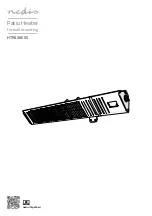
15
The temperature-pressure relief valve must be manually
operated at least once a year , see Figure 28. Caution should be
taken to ensure that (1) no one is in front of or around the outlet
of the temperature-pressure relief valve discharge line, and (2)
the water manually discharged will not cause any bodily injury
or property damage because the water may be extremely hot.
If after manually operating the valve, it fails to completely reset
and continues to release water, immediately close the cold water
inlet to the water heater, follow the draining instructions, and
replace the temperature-pressure relief valve with a new one.
Gas pIpInG
Make sure gas supplied is same type listed on model rating plate. The
inlet gas pressure must not exceed 14 inch water column (3.5 kPa)
for natural and propane gas (L.P.). The minimum inlet gas pressure
shown on rating plate is that which will permit firing at rated input.
All gas piping must comply with local codes and ordinances or with the
National Fuel Gas Code (ANSI Z223.1/ NFPA-54) or the Natural
Gas and Propane Installation Code (CAN/CSA B149.1) whichever
applies. Copper or brass tubing and fittings (except tin lined copper
tubing) should not be used.
If the gas control valve is subjected to pressures exceeding 1/2 psi
(3.5 kPa), the damage to the gas control valve could result in a fire
or explosion from leaking gas.
If the main gas line Shut-off serving all gas appliances is used, also
turn “off” the gas at each appliance. Leave all gas appliances shut
“off” until the water heater installation is complete.
A gas line of sufficient size must be run to the water heater.
Consult the current edition of National Fuel Gas Code
(ANSI Z223.1/NFPA 54) or the Natural Gas and Propane Installation
Code (CAN/CSA B149.1) and your gas supplier concerning pipe
size.
There must be:
• A readily accessible manual shut off valve in the gas supply
line serving the water heater, and
• A drip leg (sediment trap) ahead of the gas control valve to help
prevent dirt and foreign materials from entering the gas control
valve.
• A flexible gas connector or a ground joint union between the
shut off valve and control valve to permit servicing of the
unit.
Be sure to check all the gas piping for leaks before lighting the
water heater. Use a soapy water solution, not a match or open
flame. Rinse off soapy solution and wipe dry.
hIGh altItude InstallatIons
Rated inputs are suitable up to 10,100 feet (3,079m) elevation. Consult
the factory for installation at altitudes over 10,100 feet (3,079m).
WARNING: THIS HIGH EFFICIENCY WATER HEATER IS CERTIFIED
FOR USE WITHOUT MODIFICATION FOR AN ALTITUDE OF 10,100
FEET (3,079 METERS). INSTALLATIONS ABOVE THESE ALTITUDES
MAY REQUIRE REPLACEMENT OF BURNER ORIFICE. CALL THE
TECHNICAL CENTER AT (800) 527-1953 FOR
REQUIREMENTS.
Some gas utility companies derate their gas for altitude, making
it unnecessary to install high altitude orifices. Call the local gas or
utility company to verify BTU content.
Due to the input ration reduction at high altitudes, the output rating
of the appliance is also reduced and should be compensated for in
the sizing of the equipment for applications.
Use pipe joint compound or teflon tape marked as being resistant
to the action of petroleum [Propane (L.P.)] gases.
The appliance and its gas connection must be leak tested before
placing the appliance in operation.
The appliance and its individual Shut-off valve should be disconnected
from the gas supply piping system during any pressure testing of
that system at test pressures in excess of 1/2 pound per square inch
(3.5 kPa). It should be isolated from the gas supply piping system
by closing its individual manual Shut-off valve during any pressure
testing of the gas supply piping system at test pressures equal to
or less than 1/2 pound per square inch (3.5 kPa).
IMportant: MaKe sure the Gas lIne Is pIped In wIth
hard pIpe. avoId fleX lIne constructIon for Gas due
to possIBle Gas flow proBleMs.
Summary of Contents for 197835-001
Page 3: ...3 GENERAL SAFETY ...
Page 4: ...4 GENERAL SAFETY ...
Page 41: ...41 NOTES ...
Page 42: ...42 NOTES ...
















































